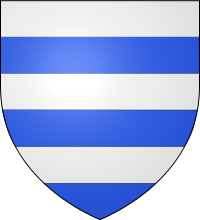
Richard Grey, 2nd Baron Grey of Codnor (died 1335), of Codnor Castle, was an English soldier and diplomat.

Richard Grey, 2nd Baron Grey of Codnor (died 1335), of Codnor Castle, was an English soldier and diplomat.
Grey was the eldest son of Henry Gray, 1st Baron Grey of Codnor (died 1308) and Eleanor de Courteney. Richard succeeded to his father's titles in 1308, upon Henry's death. Richard was one of the barons who at the assembly of Stamford on 6 August 1309, signed a letter of remonstrance to the pope on the abuses in the church. He was employed in the Scottish wars in 1311, fought during the English defeat of the Battle of Bannockburn in 1314, [1] and again in 1319–20 during the unsuccessful siege of Berwick and other confrontations against the Scots in the Scottish Marches. During the baronial revolt against King Edward II of England, known as the Despenser War, he assisted Roger Mortimer and the Marcher Lords, who attacked and plundered the Welsh possessions of royal favourite Hugh le Despenser, the younger. For these attacks, Richard was pardoned by Parliament in August 1321. [2] Together with John Giffard and Robert de Shirland, they testified to the claim of Bartholomew Badlesmere that Despenser, the younger was a traitor. [3] Misled by false letters, the rebels attempted to place Gray, Giffard and Shirland firmly on their side, [4] but from the end of 1321 Gray was firmly on the side of Edward II, who took action against the baronial opposition. Richard served with the royal army, which pursued the rebels under the command of Thomas of Lancaster to the north of England. Grey remained in the favour of the king, who visited him after the victory over Lancaster in March 1322 at Grey's castle at Codnor, Derbyshire.
In 1324 Gray was appointed to the office of Seneschal of Gascony and Steward of the Duchy of Aquitaine. [5] Gray resigned this office, in October 1324, serving Edmund of Woodstock, Earl of Kent during the war in Gascony. He was then sent to defend Argentan, in the Duchy of Normandy. In 1326, Richard was Constable of Nottingham Castle and in 1327 he was employed in the Scotch marches, and was summoned for the Scottish war in 1334, but was excused on the ground of sickness. He died in 1335.
Richard married Joan, daughter of Robert FitzPayne, Lord FitzPayne and Isbella de Clifford.
His son Robert, took his mother's maiden name and became known as Robert FitzPayne.

Edward II, also called Edward of Caernarfon, was King of England from 1307 until he was deposed in January 1327. The fourth son of Edward I, Edward became the heir to the throne following the death of his older brother Alphonso. Beginning in 1300, Edward accompanied his father on campaigns to pacify Scotland, and in 1307 he was knighted in a grand ceremony at Westminster Abbey. Edward succeeded to the throne later that year, following his father's death. In 1308, he married Isabella of France, the daughter of the powerful King Philip IV, as part of a long-running effort to resolve the tensions between the English and French crowns.
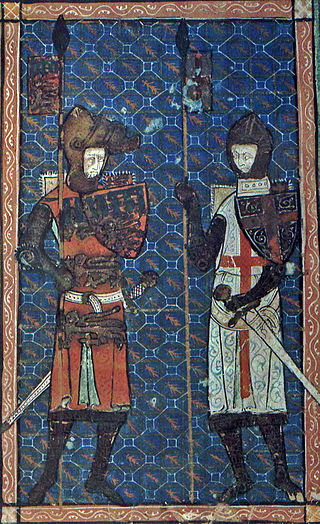
Thomas, 2nd Earl of Lancaster was an English nobleman of the first House of Lancaster of the royal Plantagenet Dynasty. He was Earl of Lancaster, Leicester, and Derby from 1296 to 1322, and Earl of Lincoln and Salisbury jure uxoris from 1311 to 1322. As one of the most powerful barons of England, Thomas was one of the leaders of the baronial opposition to his first cousin, King Edward II.

Edmund Fitzalan, 2nd Earl of Arundel was an English nobleman prominent in the conflict between King Edward II and his barons. His father, Richard Fitzalan, 1st Earl of Arundel, died in 1302, while Edmund was still a minor. He, therefore, became a ward of John de Warenne, Earl of Surrey, and married Warenne's granddaughter, Alice. In 1306 he was styled Earl of Arundel, and served under Edward I in the Scottish Wars, for which he was richly rewarded.

Henry, 3rd Earl of Leicester and Lancaster was a grandson of King Henry III of England (1216–1272) and was one of the principals behind the deposition of King Edward II (1307–1327), his first cousin.

Roger Mortimer, 3rd Baron Mortimer of Wigmore, 1st Earl of March, was an English nobleman and powerful Marcher Lord who gained many estates in the Welsh Marches and Ireland following his advantageous marriage to the wealthy heiress Joan de Geneville, 2nd Baroness Geneville. Her mother was of the Royal House of Lusignan.
The title of Baron Grey of Codnor is a title in the peerage of England.
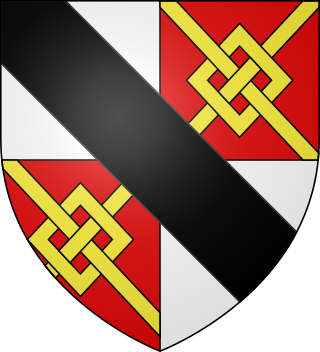
Hugh le Despenser, sometimes referred to as "the Elder Despenser", was for a time the chief adviser to King Edward II of England. He was created a baron in 1295 and Earl of Winchester in 1322. One day after being captured by forces loyal to Sir Roger Mortimer and Edward's wife, Queen Isabella, who were leading a rebellion against Edward, he was hanged and then beheaded.

Hugh Despenser, 1st Baron Despenser, also referred to as "the Younger Despenser", was the son and heir of Hugh Despenser, Earl of Winchester, and his wife Isabel Beauchamp, daughter of William Beauchamp, 9th Earl of Warwick. He rose to national prominence as royal chamberlain and a favourite of Edward II of England. Despenser made many enemies amongst the nobility of England. After the overthrow of Edward, he was eventually charged with high treason and ultimately hanged, drawn and quartered.

Eleanor de Clare, suo jure 6th Lady of Glamorgan was a powerful Anglo-Welsh noblewoman who married Hugh Despenser the Younger, the future favourite of Edward II of England, and was a granddaughter of Edward I of England. With her sisters, Elizabeth de Clare and Margaret de Clare, she inherited her father's estates after the death of her brother, Gilbert de Clare, 8th Earl of Gloucester, 7th Earl of Hereford at the Battle of Bannockburn in 1314. She was born in 1292 at Caerphilly Castle in Glamorgan, Wales and was the eldest daughter of Gilbert de Clare, 6th Earl of Hertford, 7th Earl of Gloucester, 5th Lord of Glamorgan and Princess Joan of Acre.
Gilbert de Clare, 8th Earl of Gloucester, 7th Earl of Hertford was an English nobleman and military commander in the Scottish Wars. In contrast to most English earls at the time, his main focus lay in the pursuit of war rather than in domestic political strife. He was the son of Gilbert de Clare, 7th Earl of Gloucester, and Joan of Acre, daughter of King Edward I. The older Gilbert died when his son was only four years old, and the younger Gilbert was invested with his earldoms at the young age of sixteen. Almost immediately, he became involved in the defence of the northern border, but later he was drawn into the struggles between Edward II and some of his barons. He was one of the Lords Ordainers who ordered the expulsion of the king's favourite Piers Gaveston in 1311. When Gaveston was killed on his return in 1312, Gloucester helped negotiate a settlement between the perpetrators and the king.
Events from the 1320s in England.
Joan de Geneville, 2nd Baroness Geneville, Countess of March, Baroness Mortimer, also known as Jeanne de Joinville, was the daughter of Sir Piers de Geneville and Joan of Lusignan. She inherited the estates of her grandparents, Geoffrey de Geneville, 1st Baron Geneville, and Maud de Lacy, Baroness Geneville. She was one of the wealthiest heiresses in the Welsh Marches and County Meath, Ireland. She was the wife of Roger Mortimer, 1st Earl of March, the de facto ruler of England from 1327 to 1330. She succeeded as suo jure 2nd Baroness Geneville on 21 October 1314 upon the death of her grandfather, Geoffrey de Geneville.
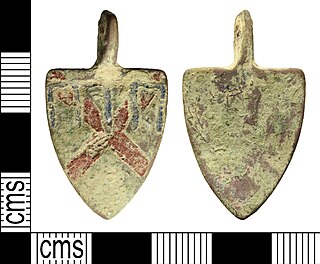
Margaret de Badlesmere, Baroness Badlesmere was a Anglo-Norman noblewoman, suo jure heiress, and the wife of Bartholomew de Badlesmere, 1st Baron Badlesmere.
Elizabeth de Comyn was a medieval noblewoman and heiress, notable for being kidnapped by the Despenser family towards the end of the reign of King Edward II.

The invasion of England in 1326 by the country's queen, Isabella of France, and her lover, Roger Mortimer, led to the capture and executions of Hugh Despenser the Younger and Hugh Despenser the Elder and the abdication of Isabella's husband, King Edward II. It brought an end to the insurrection and civil war.
The Despenser War (1321–22) was a baronial revolt against Edward II of England led by the Marcher Lords Roger Mortimer and Humphrey de Bohun. The rebellion was fuelled by opposition to Hugh Despenser the Younger, the royal favourite. After the rebels' summer campaign of 1321, Edward was able to take advantage of a temporary peace to rally more support and a successful winter campaign in southern Wales, culminating in royal victory at the Battle of Boroughbridge in the north of England in March 1322. Edward's response to victory was his increasingly harsh rule until his fall from power in 1326.
Sir William Trussell was an English politician and leading rebel in Queen Isabella and Roger Mortimer, 1st Earl of March's rebellion against Edward II. William acted as Speaker of the House of Commons and renounced the allegiance of England to Edward II, forcing his abdication, and became King Edward III's Secretary.
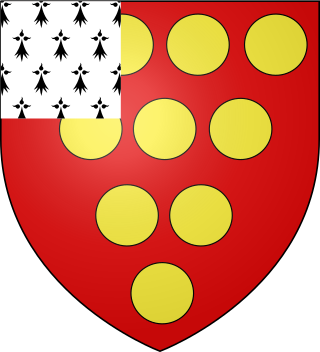
William la Zouche, 1st Baron Zouche (1276/86–1352), lord of the manor of Harringworth in Northamptonshire, was an English baron and soldier who fought in the Wars of Scottish Independence. He is referred to in history as "of Harringworth" to distinguish him from his first cousin Alan la Zouche, 1st Baron la Zouche (1267–1314) of Ashby de la Zouch in Leicestershire.
The Seneschal of Gascony was an officer carrying out and managing the domestic affairs of the lord of the Duchy of Gascony. During the course of the twelfth century, the seneschalship, also became an office of military command. After 1360, the officer was the Seneschal of Aquitaine. There was an office above the seneschalcy, the Lieutenancy of the Duchy of Aquitaine, but it was filled only intermittently.